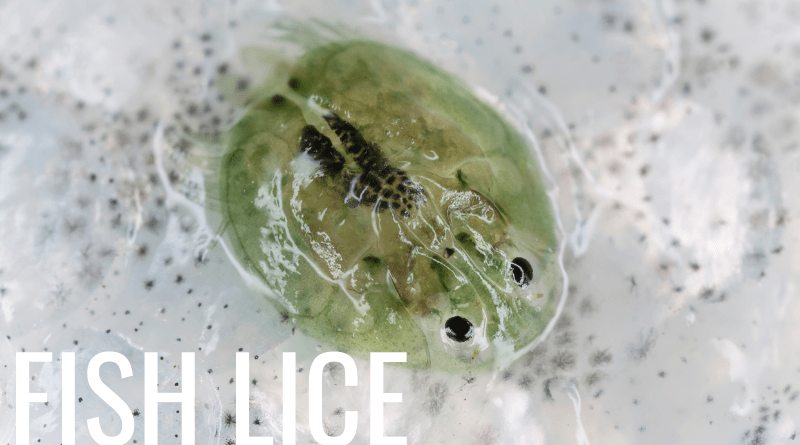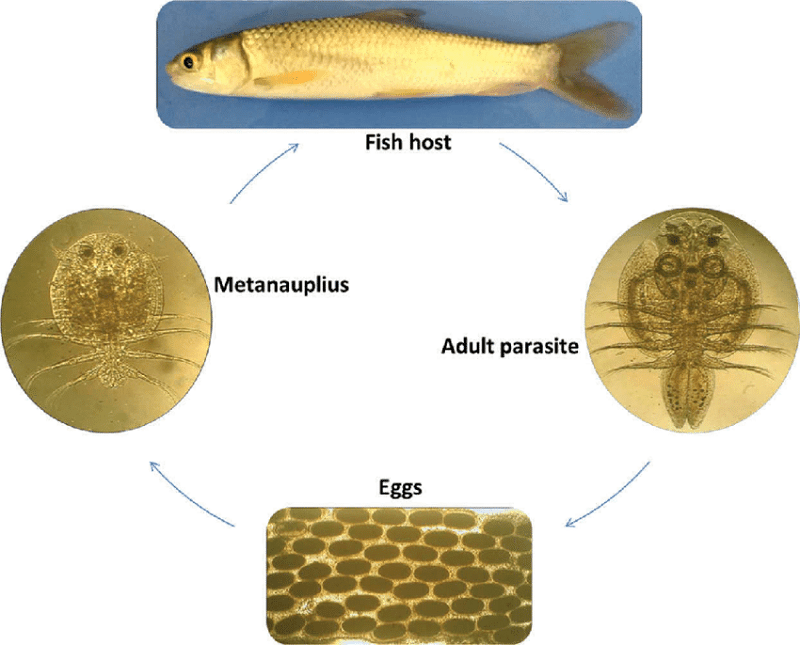How to Get Rid of Fish Lice in My Pond (Fish Lice Treatment)
Pond Academy is reader-supported. Buying through links on our site may earn us an affiliate commission. As an Amazon Associate I earn from qualifying purchases.
Found in marine and freshwater environments, fish lice belong to the Argulidae family of crustacean parasites.
And, unfortunately, fish lice can be deadly to your pond fish!
For this reason, you should treat them in your pond as soon as you become aware of the pesty problem.
But, how do you know you have a fish lice problem? And how do you get rid of them if you do?
Let's learn how to identify if your pond has fish lice, how to get rid of fish lice in a pond, and how to make sure they never return!
What Are Fish Lice?

Fish lice aren't lice as we typically know them. They are external crustacean parasites that latch onto the body of their host.
![]() Did you know...
Did you know...
Fish lice's scientific name is argulus, and they are also known as fish louse.
Once they've attached to their host, these free-swimming crustaceans feed on fish blood.
They are commonly found in pet fish, especially goldfish and Koi. They can survive in freshwater and saltwater. And they reproduce by laying long strips of eggs on any hard surface.
Female fish lice start laying eggs in the spring when temperatures reach around 50°F and continue laying eggs throughout the year until water temperatures dip below 50°F. The eggs take about 16 days to hatch in warm climates. If they don't find a host within a few days, they will die.
Many adult fish lice die off during the winter months, only to resurface in the spring. These parasites are commonly found in koi ponds, aquariums, and fisheries worldwide. They are round, flat, jelly-like parasites that feed on skin, blood, and mucus.

The above image displays the life cycle of Argulus parasites, aka fish lice.
Get Our Best Pond Tips Sent to Your Inbox for Free!
Join thousands of others and learn from our decades of pond building and maintenance experience! Your pond will thank you!
By subscribing you agree to receive emails from PondAcademy.com. We will always respect your privacy and you can unsubscribe at any time.
How Dangerous Are Fish Lice?
Fish lice are most common in outdoor ponds but can be transferred to aquariums by wild or pond-raised fish. When left untreated, fish lice are a significant threat to fish health since major infestations can cause disease and eventually death.
Health Consequences Of Fish Lice
Since fish don't have fur or hair, fish lice have to work extra hard to attach to a host, using their antennae and suckers to accomplish this task. Once attached, fish lice feed off of the host's skin, muscle, and mucus, often resulting in bleeding and infection.
Fish will rub against underwater objects or substrates to get rid of the highly irritating fish lice. Infected fish may also jump and dive to the bottom of a fish tank or pond and roll onto their sides while trying to dislodge the lice.
This behavior often injures a fish's scales and fins and is sometimes more dangerous than the lice themselves. If the fish is large and healthy, a few fish lice are uncomfortable but not necessarily fatal.
Heavy infestations, however, weaken fish and may cause them to lose color or their appetite due to the stress of dealing with the infestation. This can kill fish, particularly if they are smaller.
Source Of Fish Lice
Fish lice can find their way to your pond in a few ways:
- Visiting frogs and toads can introduce the lice into a pond if they are infected.
- Infested fish introduced into a pond is also a common source of these parasites.
- Another common cause is unsterilized wild plants.
How To Identify Fish Lice
Fish lice infestations tend to peak in the summer and fall months. There are over one hundred different species of fish lice found worldwide. As we mentioned earlier, they are visible without a microscope.
You can quickly identify these parasites based on their broad and flat bodies, often in an oval shape. They have a shell and eight legs for swimming. You can see fish lice swimming in your pond's water or moving around on the host. These parasites look somewhat like a small brown or pale crab.
The lice will sometimes let go of one fish and swim to another for an extra meal, but they cannot live for long periods without a host. They may also appear as dark, flat oval dots crawling on the host. You can find the lice attached to the infected fish's skin, gill chamber, and mouth.
Signs Of Fish Lice Infestation
Fish suffering from a fish lice infestation often display physical and behavioral signs. Some fish may not show any outward signs of infection, but you may be able to spot non-specific signs of infection. Observing your fish's behavior is the best way to detect a fish lice infestation early.
Physical Signs
- Fish lice visible on the skin, gills, and fins
- Darks spots on fish's skin
- Ulcers, red marks, skin inflammation
- Stunted growth
- Scales peeling off
Behavior Signs
- Erratic swimming
- Reduced Feeding
- Hanging at the surface
- Rubbing against surfaces in the pond to relieve irritation
- Aggravation and restlessness
Lice won't always be visible on your fish. In that case, look for other infestation signs such as spot or pinpoint hemorrhages, fin and scale loss, anemia, poor body condition, lethargy, and increased mucus production. Infected fish may also appear weak and emaciated.
How To Get Rid Of Fish Lice In My Pond
You can effectively treat a fish lice infestation in your pond by attacking quickly to treat the infected fish and the pond. When using chemicals to treat a lice infestation, you should consider the parasite's life cycle, ranging from between 30 and 60 days.
Treatment will also depend on the severity of the fish lice infestation. Luckily, there are chemical and natural options for getting rid of these parasites.
Chemical Treatments
While there are no FDA-approved drugs for fish lice treatment, experts have used several medications to treat fish lice infestations. These treatments target the parasite's full life cycle, including eggs, juveniles, and adults.
Cyromazine
Cyromazine is an effective treatment for fish lice and anchor worms, as well. This compound is effective at killing both eggs and growing larvae. Plus, it won't harm your biological filtration system.
If using Microbe-Lift Lice & Anchor Worm Treatment, apply three treatments, each a week apart with partial water changes prior to each treatment. Make sure the water temperature is above 40º F when treating.
Diflubenzuron
Another effective remedy is Diflubenzuron, which interrupts the shedding of the parasite's outer layer of skin, killing the parasite at the larval and adult stages.
If using Dimilin-X Koi & Goldfish Treatment, apply one teaspoon for every 500 gallons of water around the perimeter of your pond. Reapply after 3 to 5 days, not exceeding 3 treatments per month.
Other Chemical Options
Other chemical compounds that have proven effective against fish lice include Lufenuron and Potassium Permanganate. In several studies, Potassium Permanganate has effectively killed juvenile and adult stages of fish lice.
Manual Removal of Fish Lice
If only a few fish in your pond are suffering from fish lice, you may be able to manually remove the parasites by pulling them out of the infected fish's body with a pair of forceps. If you're treating goldfish, you can hold them in a damp cloth and remove the lice using tweezers.
You can see the fish lice removal process in this video.
After you have manually removed the fish lice, you'll need to treat the wound. Cleaning the would with an antiseptic such as Neosporin is an excellent option. Alternatively, you could follow manual treatment by placing the fish in a bath for a little getaway with a weak permanganate solution for two to three minutes.
Important: You should closely monitor wounds for secondary infection. There's also a risk you'll miss some lice during manual removal. Furthermore, manual removal doesn't remove the lice from the environment. You must be sure to treat the infected pond as well.
Other Treatment Methods
Draining a pond with a serious fish lice infestation helps control the issue. Other methods to help fish cope with an infestation is fixing wooden bamboo poles inside the pond to give the fish a place to rub their bodies against to remove the parasites.
Applying lime to the affected pond after exposing it to sunlight for at least 24 hours and removing all of the fish is another method for eliminating fish lice. Allow the pond to dry for at least 48 hours to eradicate fish lice eggs.
Preventing Fish Lice Infestations
The question of how to get rid of fish lice in my pond shouldn't be your only concern. Prevention is the best method for avoiding a fish lice outbreak. Pond fish commonly carry parasites but often show no symptoms when purchased at a pet store.
Quarantining new fish may seem sad, but it is the most effective step you can take to prevent fish lice infestations in your pond. You should quarantine new fish for a week to ten days. Think of it as a vacation for your fish.
You should observe the fish during the quarantine, immediately isolating and treating any fish that show signs of a parasitic infection. Be sure to isolate newly purchased pond plants for several days before introducing them to your pond, as well.
Maintaining optimal water quality in your pond is also an essential component of preventing fish lice. Regularly clean your pond and check your pond's pH levels and temperature. Following these steps will minimize the risk of lice infestations in your pond.







